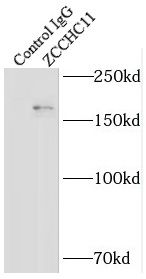Products
TUT4 antibody
| Size | Price |
|---|---|
| 100µg | Inquiry |
- SPECIFICATIONS
- FIGURES
- CONDITIONS
- FAQS
- Product Name
- TUT4 antibody
- Catalogue No.
- FNab09609
- Size
- 100μg
- Form
- liquid
- Purification
- Immunogen affinity purified
- Purity
- ≥95% as determined by SDS-PAGE
- Clonality
- polyclonal
- Isotype
- IgG
- Storage
- PBS with 0.02% sodium azide and 50% glycerol pH 7.3, -20℃ for 12 months(Avoid repeated freeze / thaw cycles.)
- Immunogen
- zinc finger, CCHC domain containing 11
- Alternative Names
- Terminal uridylyltransferase 4 (TUTase 4)|Zinc finger CCHC domain-containing protein 11|TUT4|KIAA0191|ZCCHC11 antibody
- UniProt ID
- Q5TAX3
- Observed MW
- 185 kDa
- Tested Applications
- ELISA, WB, IF, IP
- Recommended dilution
- WB: 1:200-1:2000; IP: 1:500-1:5000; IF: 1:20-1:200
 MCF7 cells were subjected to SDS PAGE followed by western blot with FNab09609(ZCCHC11 antibody) at dilution of 1:500
MCF7 cells were subjected to SDS PAGE followed by western blot with FNab09609(ZCCHC11 antibody) at dilution of 1:500
 IP Result of anti-ZCCHC11 (IP:FNab09609, 5ug; Detection:FNab09609 1:1000) with MCF-7 cells lysate 2000ug.
IP Result of anti-ZCCHC11 (IP:FNab09609, 5ug; Detection:FNab09609 1:1000) with MCF-7 cells lysate 2000ug.
- Background
- Uridylyltransferase that mediates the terminal uridylation of mRNAs with short(less than 25 nucleotides) poly(A) tails, hence facilitating global mRNA decay(PubMed:25480299). Involved in microRNA(miRNA)-induced gene silencing through uridylation of deadenylated miRNA targets. Also acts as a suppressor of miRNA biogenesis by mediating the terminal uridylation of some miRNA precursors, including that of let-7(pre-let-7), miR107, miR-143 and miR-200c. Uridylated miRNAs are not processed by Dicer and undergo degradation. Degradation of pre-let-7 contributes to the maintenance of embryonic stem(ES) cell pluripotency(By similarity). Does not bind RNA directly, but recruited to RNA targets by RNA-binding protein LIN28A. Also catalyzes the 3' uridylation of miR-26A, a miRNA that targets IL6 transcript. This abrogates the silencing of IL6 transcript, hence promoting cytokine expression(By similarity). May also suppress Toll-like receptor-induced NF-kappa-B activation via binding to T2BP. Does not play a role in replication-dependent histone mRNA degradation. Due to functional redundancy between ZCCHC6 and ZCCHC11, the identification of the specific role of each of these proteins is difficult.
How many times can antibodies be recycled?
First, usually it's not suggested to recycle antibodies. After use, buffer system of antibodies has changed. The storage condition of recycled antibodies for different customers also varies. Thus, the performance efficiency of recycled antibodies can’t be guaranteed. Besides, FineTest ever conducted the antibody recycling assay. Assay results show recycling times of different antibodies also varies. Usually, higher antibody titer allows more repeated use. Customers can determine based on experimental requirements.
Notes: After incubation, we recycle rest antibodies to centrifuge tube and store at 4℃. High titer antibodies can be stored for a minimum of one week. Reuse about three times.
What are components of FineTest antibody buffer?
Components of FineTest antibody buffer are usually PBS with proclin300 or sodium azide, BSA, 50% glycerol. Common preservative is proclin300 or sodium azide, which is widely applied in the lab and industry.
How about the storage temperature and duration of FineTest antibodies?
Most antibodies are stored at -20℃. Directly-labeled flow cytometry antibodies should be stored at 2 - 8℃. The shelf life is one year. If after sales issues for purchased antibodies appear, return or replacement is available. Usually, antibodies can be still used after the one-year warranty. We can offer technical support services.
Is dilution required for FineTest antibodies? What’s the dilute solution?
Directly-labeled flow cytometry antibodies are ready-to-use without dilution. Other antibodies are usually concentrated. Follow the dilution ratio suggested in the manual. Dilute solution for different experiments also varies. Common antibody dilution buffers are acceptable(e.g. PBST, TBST, antibody blocking buffer).
How to retrieve antibodies for immunohistochemistry?
Common retrieval buffers: Tris-EDTA Buffer(pH 9.0); Citrate Buffer(pH 6.0)
Heat induced antibody retrieval:
Method 1: Water-bath heating: Put the beaker with retrieval buffer and slide in the boiling water bath. Keep the boiling state for 15min. Naturally cool to room temperature;
Method 2: Microwave retrieval: Put the beaker with retrieval buffer and slide in the microwave oven. Heat at high power for 5min, Switch OFF for 3min, Heat at medium power for 5min. Naturally cool to room temperature.
How to choose secondary antibodies?
(1) Secondary antibodies react with primary antibodies. Thus, secondary antibodies should be against host species of primary antibodies. E.g. If the primary antibody is derived from rabbit, the relevant secondary antibody should be against rabbit. E.g. goat anti rabbit or donkey anti rabbit.
(2) Choose secondary antibody conjugates according to the experimental type, e.g. ELISA, WB, IHC etc. Common enzyme conjugated secondary antibodies are labelled by HRP, AP etc. Fluorescin or dye labelled secondary antibodies are applied in immunofluorescence and flow cytometry(e.g. FITC, Cy3).
